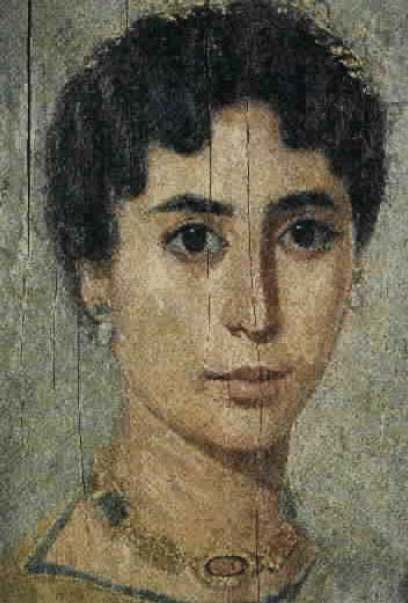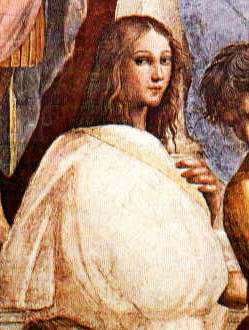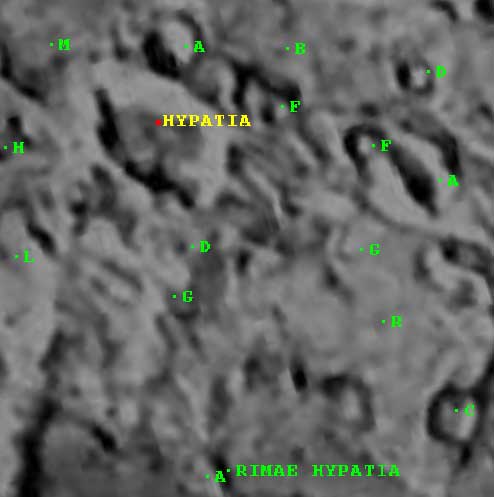.
Reserve your right to think, for even to think wrongly is better than not to think at all
Hypatia (c. 350-370? – 415) AD
|
So then once it happened that Cyril who was bishop of the opposing faction, passing by the house of Hypatia, saw that there was a great pushing and shoving against the doors, "of men and horses together, some approaching, some departing, and some standing by. When he asked what crowd this was and what the tumult at the house was, he heard from those who followed that the philosopher Hypatia was now speaking and that it was her house. When he learned this, his soul was bitten with envy, so that he immediately plotted her death, a most unholy of all deaths. For as she came out as usual many close-packed ferocious men, truly despicable, fearing neither the eye of the gods nor the vengeance of men, killed the philosopher, inflicting this very great pollution and shame on their homeland. Suda |
Of the more than 300 listed mathematicians of ancient Greece [1], about 12% were women. Most of them were connected with the Pythagorean School and of Ionian origin. This number is not larger in our modern times and shows that the situation of women in ancient Greece was not worse or better than in our times. The first "known" mathematician Aithra, leads the list of both men and women. The last important mathematician in the Greek line was Hypatia of Alexandria (Υπατία η Αλεξανδρινή ) .

From Euphrosyne Doxiadis (1995): The Mysterious Fayum Portraits: Faces from Ancient Egypt, Portrait of a woman, probably from er-Rubayat, c. 160-170 AD British Museum, London, An idea of how Hypatia might have looked.
Hypatia of Alexandria (350-370 to 415 AD) was one of the first women to make a substantial contribution to the development of mathematics. (history page of the School of Mathematics and Statistics, St Andrews Scotland)
Hypatia was the daughter of the mathematician and philosopher Theon of Alexandria and it is fairly certain that she studied mathematics under the guidance and instruction of her father. Hypatia became head of the Platonist school at Alexandria in about 400 AD. There and in Athens she lectured on mathematics and in particular the philosophy of Neoplatonism. Hypatia based her teachings on those of Plotinus, the founder of Neoplatonism, and Iamblichus who was a developer of Neoplatonism around 300 AD. She was described by all commentators as a charismatic teacher (and also very beauty) and hundreds of students visited her lectures. The Suda encyclopaedia describes a scene of someone seeing: "a great crowd of people and horses in front of her door. Some were arriving, some departing, and others standing around. When asked why there was such a crowd there and what all the fuss was about, he was told by her followers that it was the house of Hypatia the philosopher and she was about to greet them."
Hypatia was known more for the work she did in mathematics, primarily for her work on the ideas of conic sections introduced by Apollonius. She edited the work On the Conics of Apollonius, which divided cones into different parts by a plane. This concept developed the ideas of hyperbolas, parabolas, and ellipses. With Hypatia's work on this important book, she made the concepts easier to understand, thus making the work survive through many centuries. Hypatia was the first woman to have such a profound impact on the survival of early thought in mathematics.
The hydrometer (also called an aerometer) an instrument used to determine the density of fluids is considered an invention of Hypatia.
See: http://www.maa.org/pubs/Calc_articles/ma055.pdf
Hypatia came to symbolize learning and science which the early Christians identified with paganism. In 412 AD Cyril (later St Cyril) became patriarch of Alexandria. However, the Roman prefect of Alexandria was Orestes and Cyril and Orestes became bitter political rivals as church and state fought for control. Hypatia was a friend of Orestes and this, together with prejudice against her philosophical views, which were seen by Christians to be pagan, led to Hypatia becoming the focal point of riots between Christians and non-Christians. A few years later, according to one report, Hypatia was brutally murdered by the Nitrian monks who were a fanatical sect of Christians supporting Cyril. According to another account (by Socrates Scholasticus) she was killed by an Alexandrian mob under the leadership of the reader Peter. What certainly seems indisputable is that she was murdered by Christians who felt threatened by her scholarship, learning, and depth of scientific knowledge.
According to Gibbon [2]:
On a fatal day, in the holy season of Lent, Hypatia was torn from her chariot, stripped naked, dragged to the church, and inhumanly butchered by the hands of Peter the reader (alias Peter the Lector) and a troop of savage and merciless fanatics: her flesh was scraped from her bones with sharp oyster-shells, and her quivering limbs were delivered to the flames.
Her murder coincided with the death of the pagan world. In 391 A.D., the largest repository of knowledge in the ancient world, the Library of Alexandria, was burned by a crowd of fanatic monks under the leadership of the Christian Archbishop Theophilus. The end of the Olympic games and Plato’s Academy closed by Justinian at 529 AD are a sign of this decline. Hypatias death marks the end of progress in science for about 1000 years until the spirit of ancient Greece started again to shine.
Mangasar Magurditch Mangasarian says:
“After a thousand years of night, when the world awoke from her sleep, the first song it sang was the last long of the dying Pagan world. This is wonderfully strange. In the year 1493, when the Renaissance ushered in a new era, the first book brought out in Europe was the last book written in Alexandria by a Pagan. It was the poem of Hero and Leander. The new world resumed the golden thread where the old world had lost it. The severed streams of thought and beauty met again into one current, and began to sing and shine as it rushed forth once more, as in the days of old. A Greek poem was the last product of the Pagan world; the same Greek poem was the first product of the new and renascent world.”
Was the Christianity responsible for the decline of the roman empire and the dark ages? There is a controversial discussion that is not the scope of these notes. What I think is true is that a period of many centuries had to pass until again scientific knowledge and technology again started to develop.
When Raphael submitted a draft of his School of Athens fresco to a Bishop he was asked who is the woman depicted between Heraclitus and Diogenes. Raphael replied: “Hypatia, the most famous student of the School of Athens.” The response of the Bishop: “Remove her. Knowledge of her runs counter to the belief of the faithful! Otherwise, the work is acceptable.”

Hypatia in Raphael's School of Athens Fresco.
“When the question is asked what we are to believe in regard to religion, it is not necessary to probe into the nature of things as was done by those whom the Greeks call physici. It is enough for the Christians to believe that the only cause of all created things - whether heavenly or earthly - is the goodness of the creator, the one true God.”
St. Augustine (354-430) (City of God, A.D. 415)

Hypatia crater, 46 km diameter, 1350 mt height walls 4°S – 23°E, East lunar field between NW Nectaris and southern Tranquillitatis
LINKS
Hypatia of Alexandria Site with many links with information of the primary sources about the life and work of Hypatia
References
[1] B. Spandagos - R. Spandagou - D. Traulou , Oi Maqhmatikoi ths Arxaias Elladas (Mathematicians of Ancient Greece), Athens 1994
[2] Gibbon, E., The Decline and Fall of the Roman Empire (first published 1776-1788; many subsequent editions), Chapter 47.
[3] A Journal of Feminist Philosophy http://iupjournals.org/hypatia/
Alic, M. (1986). Hypatia’s Heritage: A History of Women in Science from Antiquity to the Nineteenth Century. London: Women’s Press Ltd.
http://mathforum.org/epigone/math-history-list/toimingkex
| Ancient Greece
Science, Technology , Medicine , Warfare, , Biographies , Life , Cities/Places/Maps , Arts , Literature , Philosophy ,Olympics, Mythology , History , Images Medieval Greece / Byzantine Empire Science, Technology, Arts, , Warfare , Literature, Biographies, Icons, History Modern Greece Cities, Islands, Regions, Fauna/Flora ,Biographies , History , Warfare, Science/Technology, Literature, Music , Arts , Film/Actors , Sport , Fashion --- |

